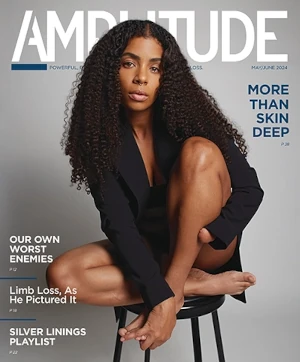I volunteered to share my experience with Ethiopian amputees. I was blown away by what they shared in return.
By Alexandra Capellini
Images by Matilde Simas
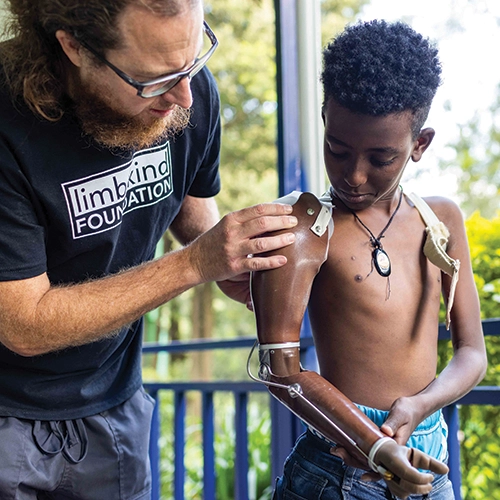
When the Limb Kind Foundation invited me to be an amputee mentor on a week-long trip to Ethiopia, I accepted with pride and enthusiasm. I have been an amputee for 20 years; I am not new to limb loss. Based on my personal experience, I was confident I could share something meaningful with the young amputees in Addis Ababa. More than that, I was curious about what I could learn from their experiences with limb loss. What did it mean to have one leg in a part of the world where access to prosthetic limbs was extremely scarce?
The Limb Kind Foundation partners with international children’s hospitals to build prosthetic limbs for young amputees in areas like Ethiopia, where fewer than one in ten amputees gets access to a prosthesis. Most of these amputees live in communities that lack the trained prosthetists, technicians, facilities, and physical materials necessary to create customized prosthetic limbs.
These communities also lack the broader support network that’s necessary to navigate living with limb loss. When Limb Kind sends a team abroad, the volunteers include prosthetists, technicians, occupational therapists, and amputee mentors. Activities range from games and recreation to physical fitness, gait training, and social gatherings. Living with limb loss is an ongoing journey, and learning what your body can do with a prosthesis can feel like continuously exploring an entirely new world. Each person who goes along on a Limb Kind trip is committed to showing young amputees how to adapt to prosthetic limbs, and what they are capable of doing with these devices.
To prepare for my week in Ethiopia, I started out by reflecting on what it’s like to live with limb loss in the United States. From my own experience, I understood that a community’s perceptions of disability can heavily influence how people in that community experience their disability. This insight helped to define my role on the Limb Kind trip. The prosthetists would be on-site to build and fit prosthetic limbs, and the PTs and OTs would help people adapt their biomechanics to the devices. I was there to offer my perspectives on how to live with a prosthesis.
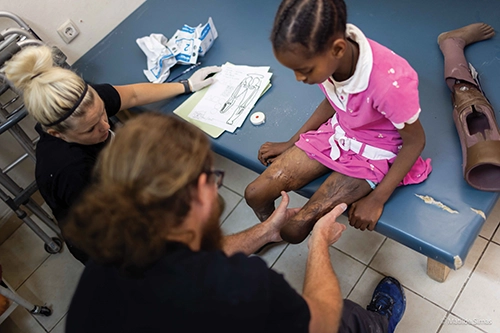
The day our team arrived at the CURE International Children’s Hospital in Addis Ababa, we were immediately welcomed with hugs, smiles, and tears. Some of the family members arriving at the hospital had never met any other amputees, aside from their own loved one. Before we had even exchanged words, I felt embraced and accepted into the community. I hadn’t expected that, and it felt incredibly energizing.
Each Ethiopian amputee went through a “fitting day,” in which prosthetists evaluated and measured their residual limbs and created molds for the prosthetic sockets. It would take several days for the prosthetic limbs to be ready. In the meantime, I and other mentors were prepared to lead recreational activities for everyone there. One of the biggest surprises of the week, however, was that the amputees and their families wanted something more than organized events: They wanted unstructured, open-ended face time with the amputee mentors.
Using translators when needed, we had conversations about different aspects of life as an amputee. The kids and their families asked us about nearly everything. Did we wear our prostheses every day? Did we wear shorts outside? Did we ever use crutches? Did we go outside with crutches? Did people stare at us? Did our families accept us? Were we able to go to school? Did we feel included by our classmates? Did we have romantic partners? Did we have jobs?
Some of the questions caught me off guard, because they addressed the most foundational aspects of my life. But I shared my daily realities with the families at CURE honestly: I wear my prosthesis almost daily. I wear shorts outside. I use crutches when needed, and I go outside with them when needed. I get stared at every day. My family accepts me. I go to school. I date. I work. I live.
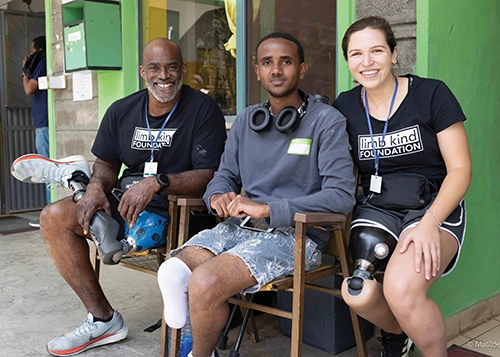
One teenage girl, missing her leg above the knee, spoke about how powerless she felt while being treated for cancer and losing her leg. Her family remained loving and supportive, but she saw the heavy emotional and financial tolls on her parents, and she couldn’t shake the idea that she was a burden. She described a deep sadness wondering if her family would be better off without her—a daughter on crutches who was missing school and could not yet work. Once she received her first prosthesis, she found freedom in moving on her own terms. The joy she found in walking also highlighted something startling to her—just how low she felt about her body as an amputee. Learning what her body could do with a prosthesis encouraged her to reframe what she told herself about her body’s abilities. Something lit up inside her, and she began focusing on what she was grateful for each day.
The amputees in our groups came from every corner of Ethiopian society. Some arrived at CURE with family or friends, while others arrived alone. Some were local residents, while others lived hours away. Some were new amputees who’d lost limbs from disease or trauma, while others had been amputees since infancy. Some were enrolled in university, while others were unable to attend school. Some were welcomed by their communities, while others were isolated. Over and over again throughout the week, people from different backgrounds and experiences wove themselves together into a unified community. We all shared an understanding and a desire: We wanted to be seen and understood by each other, our families, and the broader society.
I found myself wondering how the experiences of the amputees in our focus groups influenced the questions they asked. Some of them had never been fitted for a prosthesis before. Others had outgrown their first prostheses and relied on crutches as their bodies matured. Many were teased at school for the look of their prosthetic legs, so they wore pants or long skirts to conceal them. Likewise, some of the amputees with us felt excessively stared at in communities where disability was not widely understood or accepted. Some did not have the capacity to make the long journey to school on crutches or by wheelchair, so they could not attend. In more rural communities, local businesses were often hesitant to offer amputees jobs that required standing or ambulating, so it was difficult to secure work. As a result, some members of our groups felt burdensome to their families. They spoke of their inability to form romantic relationships or platonic friendships due to their disabilities. They did not feel desirable.
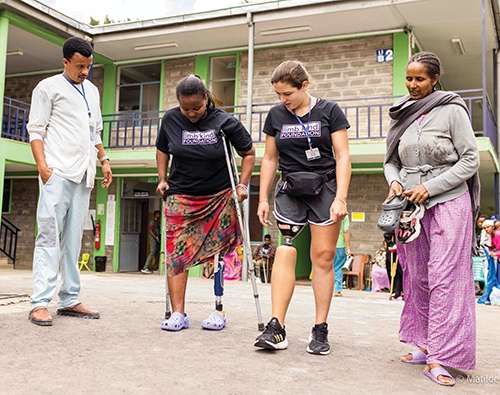
It was often difficult for me to know how to respond to these stories. Like all the other American amputee mentors on the trip, I have grappled with similar issues. I’ve asked myself what makes life as an amputee challenging, and what makes it rewarding? What do you get used to with a prosthetic limb, and what remains an ongoing test of patience? What kinds of people will judge you negatively, and what kinds of people will see you as you want to be seen?
I rose to the occasion the only way I knew how: letting myself be. I find pride in my body by enjoying my time with it. So that is what I did in Addis Ababa: I enjoyed myself. Committing to that forces me to adapt and be kinder to myself. When I am in that head space, I focus more on what my body can do and think less about how others respond to it. I find happiness that way. That becomes the energy I share. I wanted to make sure that each amputee I encountered in Ethiopia knew they could embrace that head space, too.
I could have used my time at CURE to speak about why I feel pride in my body, but I found more value in showing why—and how. After the new prosthetic limbs had been delivered and fitted, we dove back into our recreational activities. We stretched with and without our prosthetic limbs. We walked up and down slopes around the hospital. We practiced walking slow, walking fast, and everything in between. We tried some sports. We observed each other for good posture. We shared clothing and shoe recommendations. We danced. We stumbled. We practiced how to get back up.
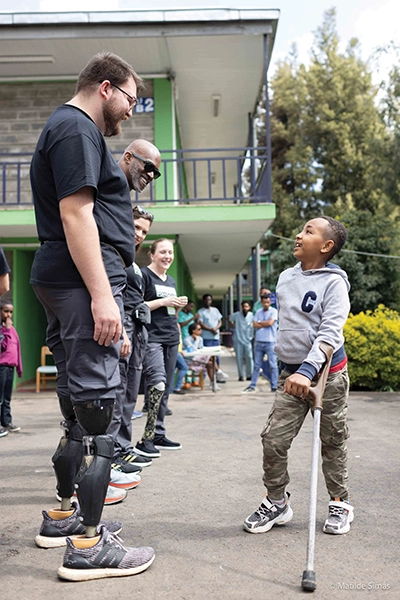
These experiences conveyed something far more powerful and sustainable than mere words of encouragement ever could. They gave our Ethiopian friends opportunities to find their own reasons for being confident in their bodies. It allowed them to recognize and believe it for themselves. It encouraged them to let go of their insecurities. In order to do that, each amputee needed to trust the environment. That’s what the Limb Kind amputee mentors did: We created a safe space. We became vulnerable ourselves.
We spoke about how to communicate our feelings to friends, family, and neighbors: what to say when we feel hurt, appreciated, isolated, respected, held back, or motivated; what to say when we need support. We spoke about what it means to rest, recharge, or push ourselves. We spoke about the difference between how others perceive us and how we perceive ourselves, what we can control, and what we can let go.
Between our Limb Kind team and the amputees receiving prosthetic devices from us, there were vast differences in cultural upbringing, access to resources, and attitudes toward disability. But rather than divide us, these differences intensified the connections between us. When we bridged these differences, all that was left was something pure and intense: our shared longing to make better sense of limb loss and find fulfillment in our bodies. It’s the heart of our experience.
I left Ethiopia with a greater appreciation for the nuances of the amputee experience. The availability of prosthetic limbs, the support systems in place, and the way communities perceive disability can dramatically affect what it is like to live with limb loss. And yet, the American amputee mentors and the young amputees in Addis Ababa were united in our desire to find value in our body types. Thousands of miles away from home, the Limb Kind team gave me an opportunity to explore common ground with children and teenagers navigating limb loss. I might be going out on a limb here, but…we caught each other.
Alexandra Capellini is a resident physician at the University of Michigan Hospital in Ann Arbor. Visit Limb Kind at limbkind.org.



